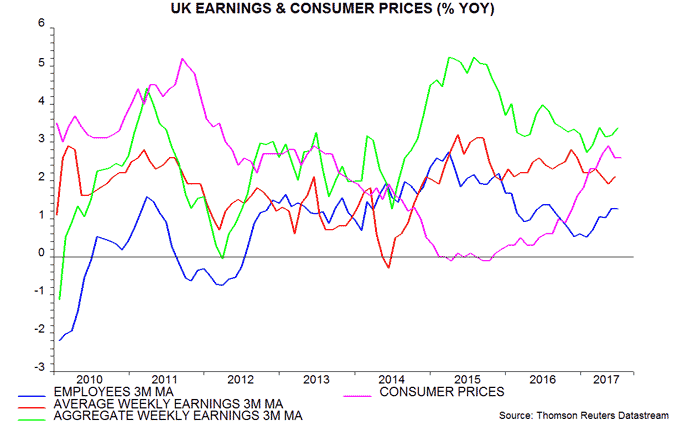UK labour market report scores for MPC hawks
UK inflation and labour market data support the case for an early rise in interest rates, in the judgement here.
Headline and core consumer price inflation were unchanged at 2.6% and 2.4% respectively in July, against expectations of rises to 2.7% and 2.5%. Both are still heading higher, however, and the July results do not suggest an undershoot of the latest Inflation Report forecast.
Core prices (i.e. excluding energy, food, alcohol and tobacco), seasonally adjusted, have risen by an average 0.2% per month in the first seven months of 2017. The average increase over August-October 2016 was only 0.1% per month. A continued gain of 0.2% per month, therefore, would imply a rise in 12-month core inflation to 2.7% by October.
The headline / core gap, meanwhile, is likely to remain positive and may widen as food inflation – 2.9% in July, the highest since 2013 – rises further. CPI food inflation is unusually low relative to producer output price inflation of food products, of 5.8% in July.
With a rise from July’s 2.6% (2.63% before rounding) likely in August / September, headline inflation is on track to meet or exceed the MPC’s forecast of 2.68% in the third quarter in the August Inflation Report.
Today’s labour market report, on balance, scores for the MPC hawks. The Inflation Report predicted that the unemployment rate would fall to 4.4% in the second quarter and stabilise during the second half. The decline to 4.4% was delivered but the single-month estimate dropped to 4.2% in June, suggesting a third-quarter undershoot – see first chart.
A wider measure of labour underutilisation encompassing involuntary part-time and discouraged workers continues to fall rapidly, reaching its lowest level since 2005 in the latest three months – first chart.
Earnings data surprised positively, with annual growth of total pay per employee firming to 2.1% in the three months to June from 1.9% in May (orginally reported at 1.8%).
For inflation control purposes, earnings growth should be assessed relative to productivity performance. Whole-economy output per hour fell by 0.1% in the year to the second quarter, according to a flash estimate also released today. Unit wage cost growth, therefore, appears to have moved above 2% last quarter.
Annual growth in aggregate earnings (i.e. average earnings multiplied by the number of employees) rose to 3.4% in the three months to June, as employment expansion remained solid at 1.2%. Aggregate earnings, therefore, continue to outpace consumer prices, supporting consumption prospects – second chart.
A minor weak point in the report was a fall in vacancies, suggesting that employment growth will cool during the second half – third chart. The decline, however, would need to extend to suggest a reversal of recent labour market strength.

Reader Comments